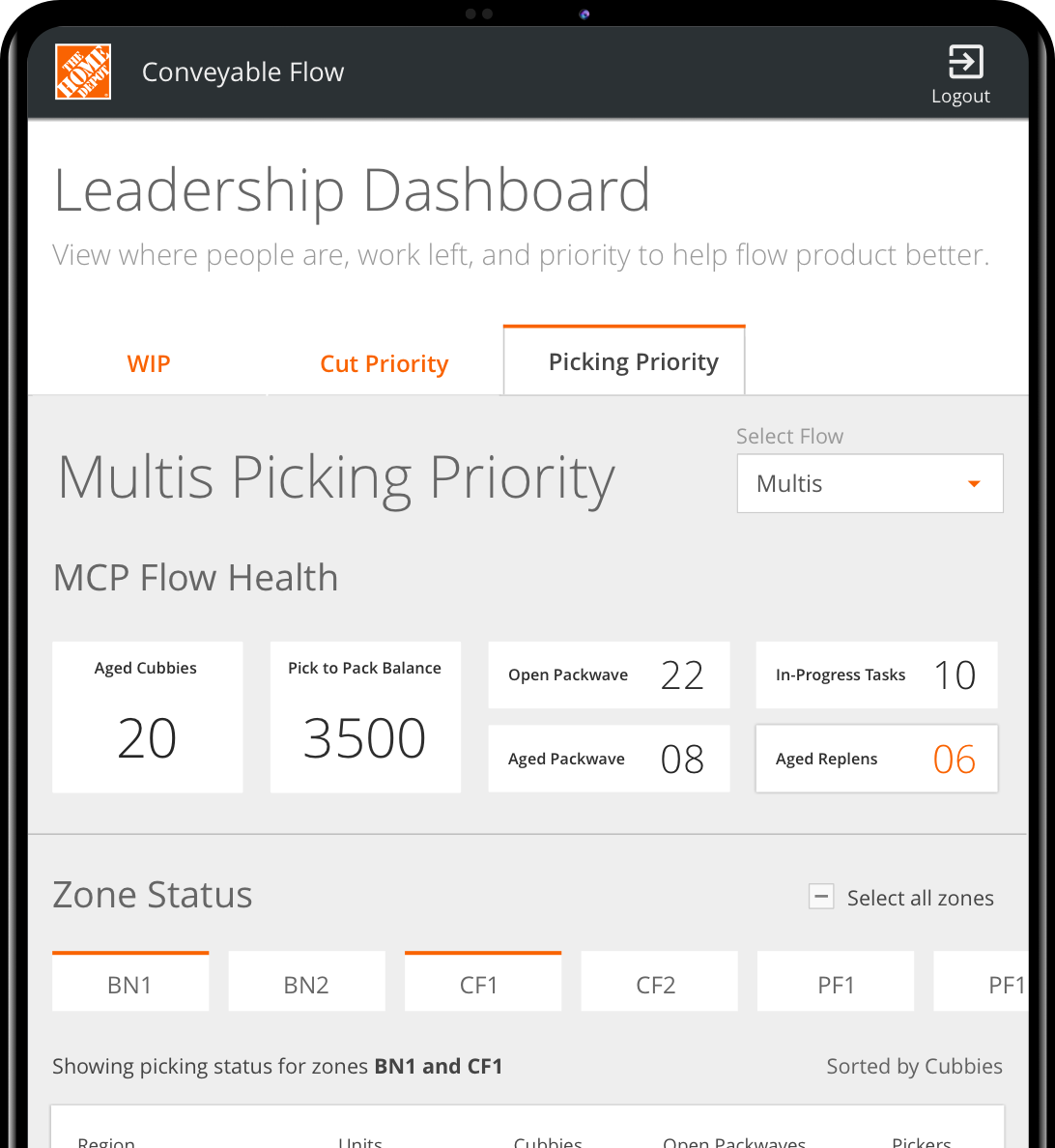
Picking Priority App
An app to help Home Depot’s Warehouse leaders prioritize picking based on customer order demand.
ROLE
Product Designer
RESPONSIBILITIES
User Research, Usability Studies, Interaction & Product Design
TIMELINE
May - Jun 2018
The Problem
Customer orders with multiple items were not being picked efficiently within The Home Depot's fulfillment centers due to lack of visibility of orders within zones and location of picking associated within the building. As a result, part of the orders was packed and the other part wasn't resulting in shipment delays.
How might we help the floor leaders visualize the relative priority and completion status of picks by flow so that they are able to direct pickers to the right region?
The Goal
Business Goal
The business' goal to reduce the time gap between when the first item and the last item within a single customer order would be picked so that they could be packed and shipped faster. This efficiency would reduce delays in shipping, shipping costs and can ultimately improve the overall customer experience.
User Goal
The outbound leaders' goal was to be able to get visibility to how many items needs to be picked from which regions within the fulfillment center, see which regions need replenishment, where their pickers currently are and direct pickers to the right region for picking customer orders.
Hypothesis
To address this issue, the Supply chain engineering team came up with a new process for picking called Conveyable Flow. This process used a system of conveyor belts within the building that would carry customers orders from various storage locations to the packing stations. This required the associates to be present in regions that had a lot of customer order volume. The floor leaders would direct the associates to go to those regions through an internal radio network.
By directing associates to the right region within the building depending on the customer order flow, we can ensure all the customer orders will be reaching the packing station on time. We will know this to be true when we see less order build-up at the packing stations and an increase in associate-picking rate.
Research & Findings
To learn more about the picking process and the people, we traveled to a Fulfillment center in Ohio and conducted interviews with the leaders and supervisors of the building. The interviews gave me an in-depth understanding of
their
process
and pain-points.
Along with the interviews, I spent time
shadowing some of the floor
associates as they were picking customer orders to understand how they receive messages and take action on them. Some of the main findings of the research are:
Research Insights
Some of the key findings from our research were:

Lack of visibility to critical information
The leaders used Excel-based tools to manage work. They needed visibility to information the excel sheets were not providing.

Slow tools affected performance
The spreadsheet tools were slow to update and required a manual update every time. This was coming in the way of making timely decisions.

Leaders miss employee engagement
The leaders prefer to work on the floor in order to be closer to their associates and ensure issues are fixed on time.

Traveling is tiring for the pickers
Pickers were frequently asked to go to different locations making them tired and less productive.
Icon Credits: Samy Menai, Graphic Tigers, Gan Khoon Lay, Antonio Cozar from the Noun Project
"Which regions are blowing up? (Getting too many orders)"
"Are the pickers following the assigned path? "
Ideation
Whiteboarding
Once the team had a good understanding of the problem and the user needs, I facilitated a whiteboarding session to explore solutions that would help provide the necessary information to the floor leaders that was necessary to make decisions. By involving the stakeholders and users in the sketching process helped us validate and narrow down quickly. We encouraged everyone to sketch their idea of presenting the necessary information and used dot voting to narrow down to the best solution. Once we had a sufficient set of ideas, we dot voted on them to prioritize and refine the ideas.

A broad set of ideas were generated during the whiteboarding session.
Sketching
The ideas that won the most votes, were then combined into a whiteboard sketch that formed the skeleton for the app.

Pulling together the refined ideas on the whiteboard.
Paper Prototyping
I quickly digitized the sketch and created paper prototypes. These were used to run quick validations through usability studies with the floor leaders. The testing helped us learn what was working and what was missing. Using paper prototypes allowed us to learn and iterate quickly.
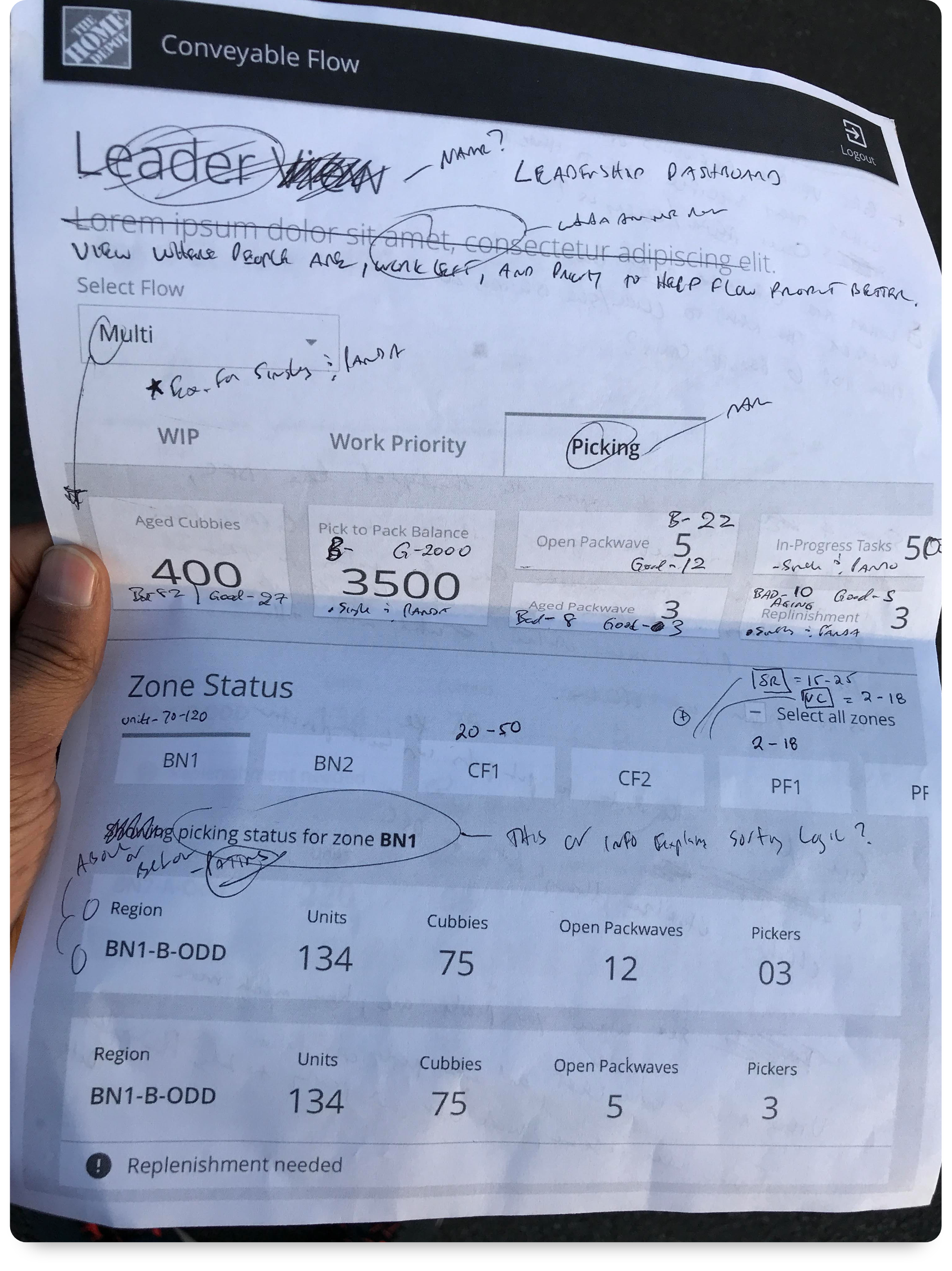
The research section is moved from the front page. This offers a more focused view of the information users need.
Final Design
The learnings helped inform the final design of the app. I used The Home Depot's Pallet Design System to create visual design. We designed for a tablet to afford the mobility. Once we knew what information they needed and the
priority of
it, I quickly created a functional prototype using Invision.
We ran 4 usability studies with the users to identify its usability of
the interface
and its effectiveness in providing users the information they need to make decisions.
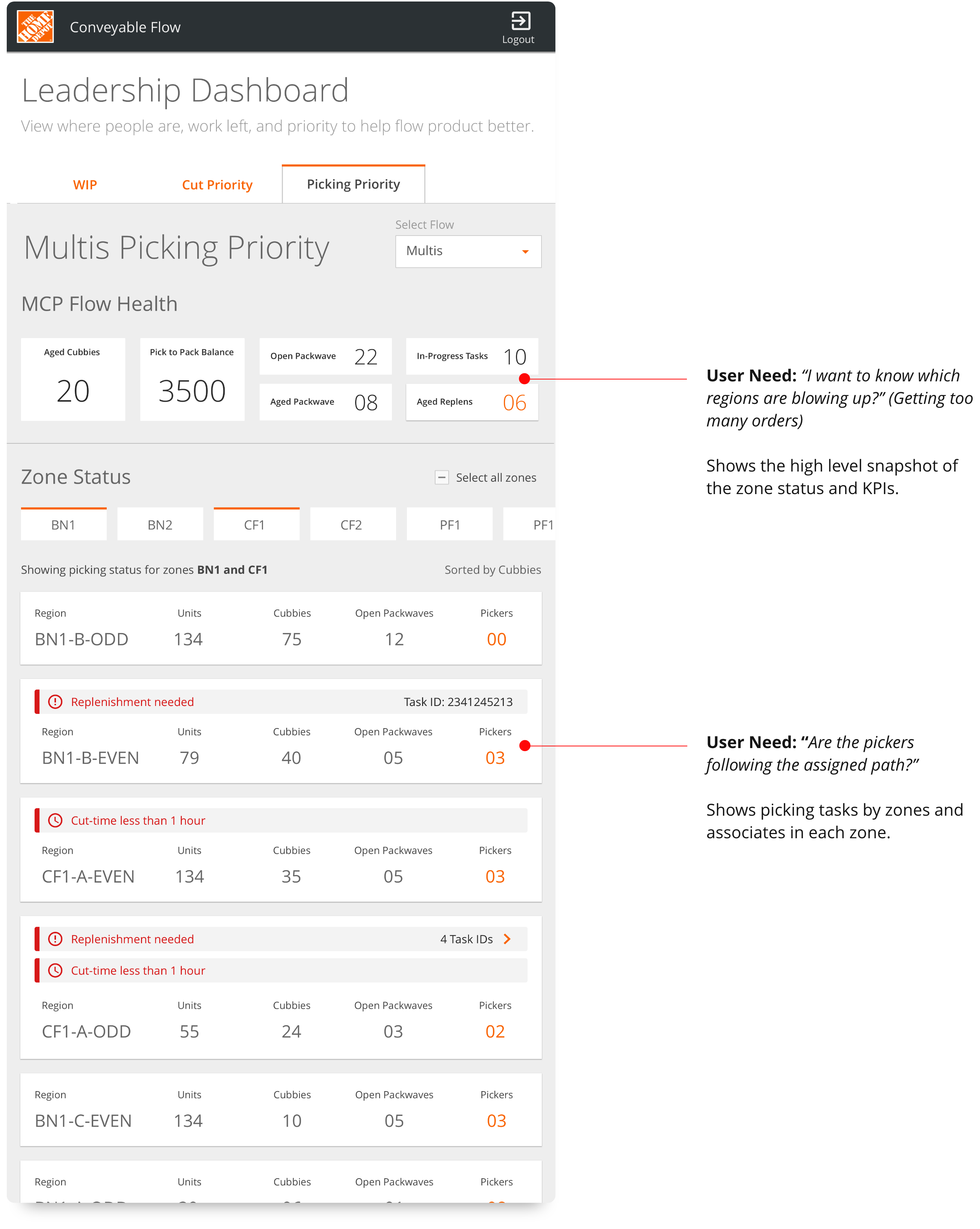
The homepage of the picking priority app within the Leadership Dashboard
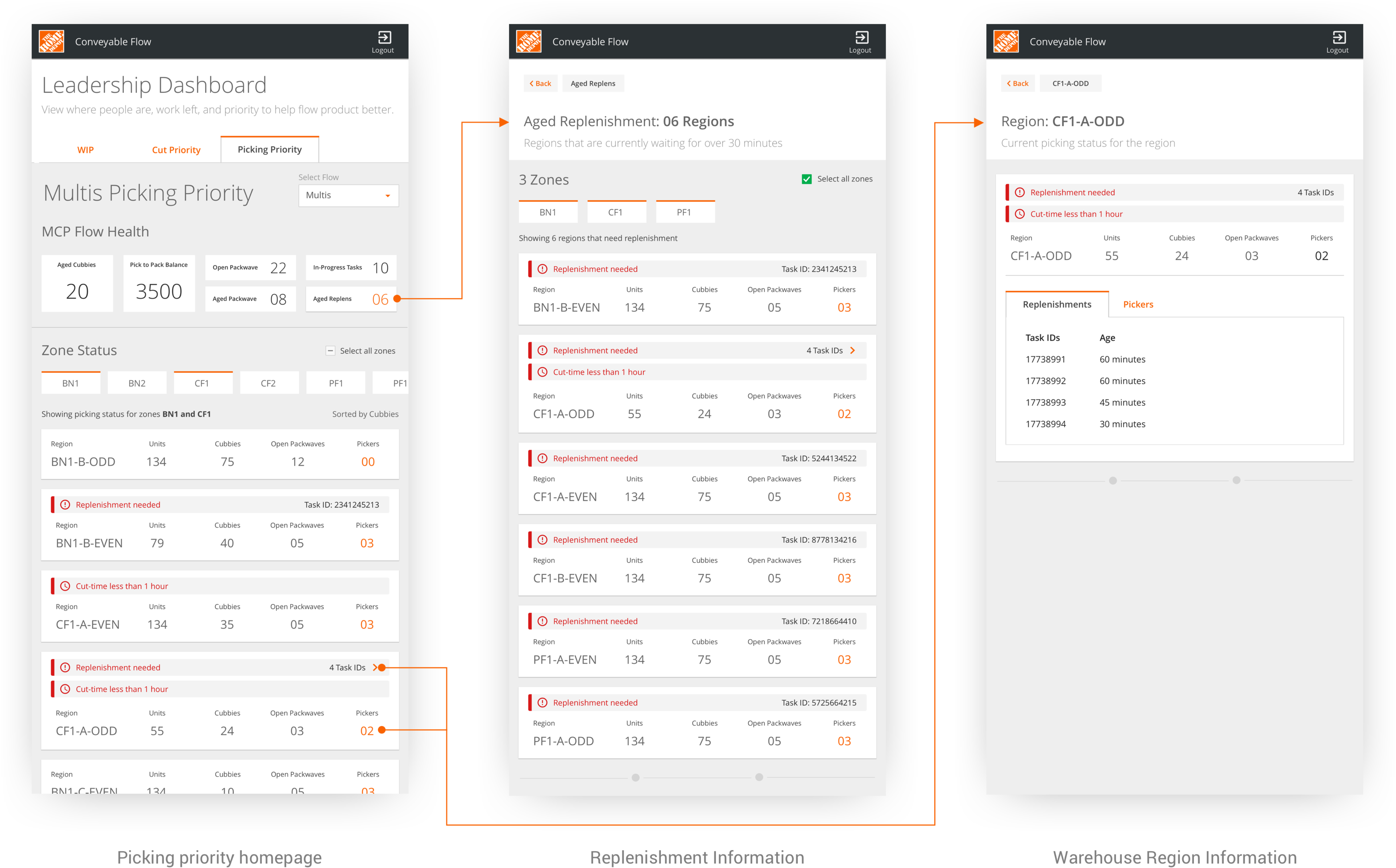
Navigation flow within the app
Picking Associate App
Along with a dashboard for the leaders, we discovered a need for the picking associates to see where they should be going to next without having to rely on their leaders for every pick. A wall-mounted display tells the pickers in
each region where to go for the next picking task.
This reduces the constant directing the leaders had to do and allows them to monitor the progress of the work.

An app for the associates that complements the leader dashboard.
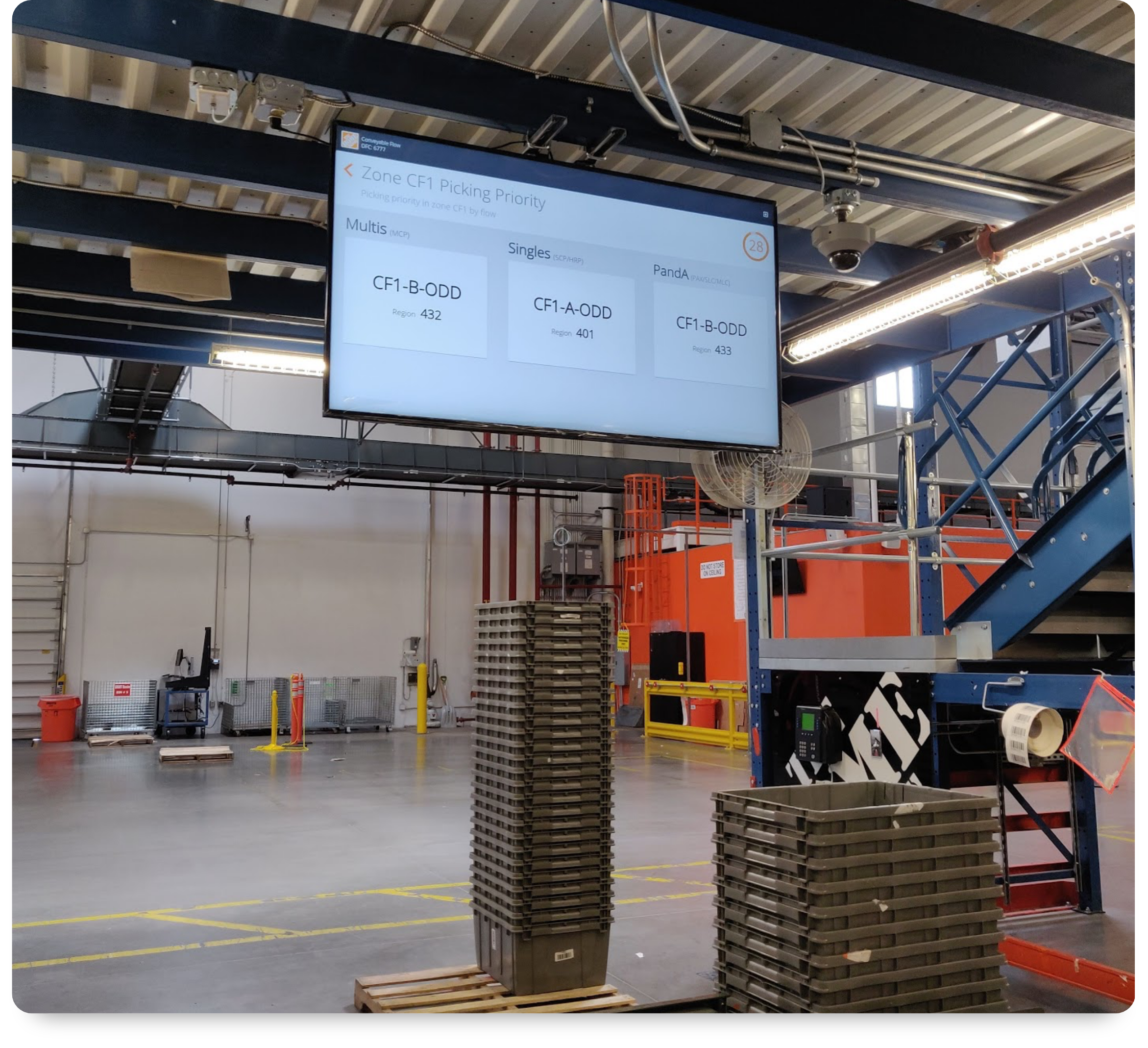
The wall-mounted display allows pickers to self-direct themselves.
Outcomes
This app was important because by reducing the delay in the picking and packing process, customer orders could be shipped out faster without any being left behind,
especially
in case of orders with multiple items.
With better visibility to the picking tasks by various zones, the floor leaders could make better decisions on where and when to direct their associates to pick customer orders. This also resulted in less traveling for the
associates, which meant they were less tired and could pick more customer orders, faster.

During the peak season of 2018, we were able to see a 25% increase in the efficiency of the picking process. The final UI was by no means the best, but in the short time we had to design and deliver, it did the job. This project helped me learn the value of prioritization and having a clear focus on the MVP while running time-compressed design sprints.
Other Works
Designed & Coded by Setu Kathawate © 2019